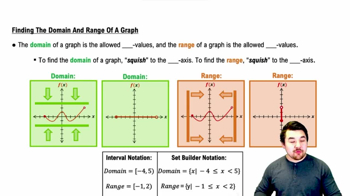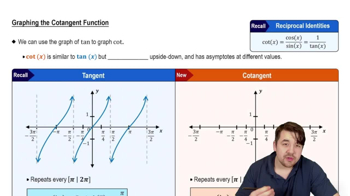Table of contents
- 0. Functions7h 52m
- Introduction to Functions16m
- Piecewise Functions10m
- Properties of Functions9m
- Common Functions1h 8m
- Transformations5m
- Combining Functions27m
- Exponent rules32m
- Exponential Functions28m
- Logarithmic Functions24m
- Properties of Logarithms34m
- Exponential & Logarithmic Equations35m
- Introduction to Trigonometric Functions38m
- Graphs of Trigonometric Functions44m
- Trigonometric Identities47m
- Inverse Trigonometric Functions48m
- 1. Limits and Continuity2h 2m
- 2. Intro to Derivatives1h 33m
- 3. Techniques of Differentiation3h 18m
- 4. Applications of Derivatives2h 38m
- 5. Graphical Applications of Derivatives6h 2m
- 6. Derivatives of Inverse, Exponential, & Logarithmic Functions2h 37m
- 7. Antiderivatives & Indefinite Integrals1h 26m
- 8. Definite Integrals4h 44m
- 9. Graphical Applications of Integrals2h 27m
- 10. Physics Applications of Integrals 2h 22m
0. Functions
Introduction to Functions
Problem 2.49
Textbook Question
Horizontal and Vertical Asymptotes
Determine the domain and range of y = (√16―x²) / (x―2).
 Verified step by step guidance
Verified step by step guidance1
Step 1: Identify the domain of the function. The domain is determined by the values of x for which the function is defined. The function y = (√(16 - x²)) / (x - 2) has two restrictions: the expression under the square root, 16 - x², must be non-negative, and the denominator, x - 2, must not be zero.
Step 2: Solve the inequality 16 - x² ≥ 0 to find the values of x for which the square root is defined. This inequality can be rewritten as x² ≤ 16, which implies -4 ≤ x ≤ 4.
Step 3: Determine the values of x that make the denominator zero. Set x - 2 = 0 and solve for x, which gives x = 2. Since the denominator cannot be zero, x = 2 is excluded from the domain.
Step 4: Combine the results from Steps 2 and 3 to find the domain. The domain is the set of all x such that -4 ≤ x ≤ 4, excluding x = 2. In interval notation, this is [-4, 2) ∪ (2, 4].
Step 5: Determine the range of the function. Consider the behavior of the function as x approaches the endpoints of the domain and the point where the denominator is zero. Analyze the limits as x approaches 2 from the left and right to identify any vertical asymptotes, and consider the maximum and minimum values of the function within the domain to determine the range.
 Verified video answer for a similar problem:
Verified video answer for a similar problem:This video solution was recommended by our tutors as helpful for the problem above
Video duration:
3mPlay a video:
Was this helpful?
Key Concepts
Here are the essential concepts you must grasp in order to answer the question correctly.
Domain of a Function
The domain of a function refers to the set of all possible input values (x-values) for which the function is defined. For rational functions, the domain is restricted by values that make the denominator zero. In this case, we need to identify any x-values that would cause the denominator (x - 2) to equal zero, as these values are excluded from the domain.
Recommended video:

Finding the Domain and Range of a Graph
Range of a Function
The range of a function is the set of all possible output values (y-values) that the function can produce. To determine the range, we analyze the behavior of the function as x approaches certain critical points, including vertical asymptotes and the limits of the function as x approaches infinity or negative infinity. This helps in understanding the values that y can take.
Recommended video:

Finding the Domain and Range of a Graph
Asymptotes
Asymptotes are lines that a graph approaches but never touches. Vertical asymptotes occur where the function is undefined, typically where the denominator is zero. Horizontal asymptotes describe the behavior of the function as x approaches infinity or negative infinity, indicating the value that y approaches. Understanding these concepts is crucial for analyzing the overall behavior of the function.
Recommended video:

Introduction to Cotangent Graph

 1:36m
1:36mWatch next
Master Introduction to Calculus Channel with a bite sized video explanation from Callie
Start learning




